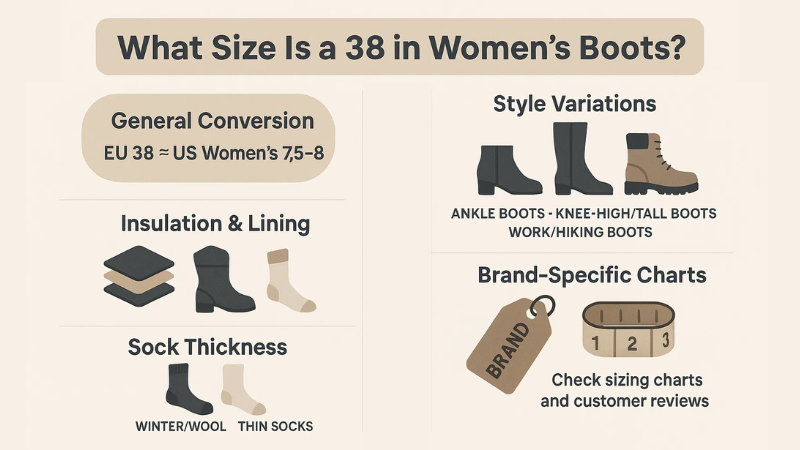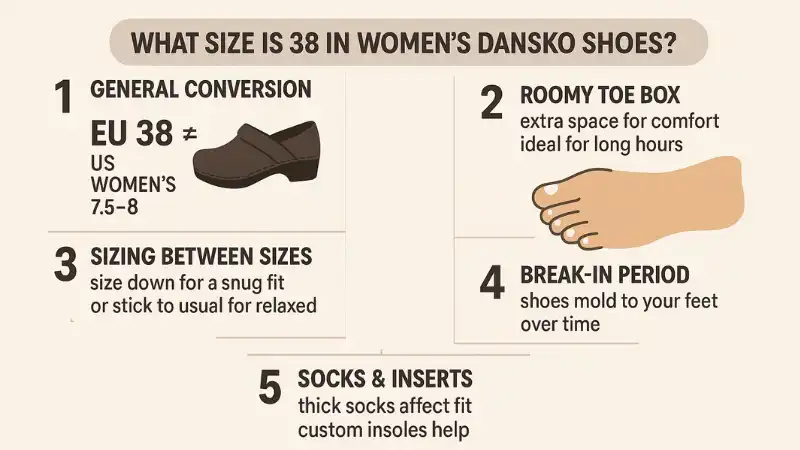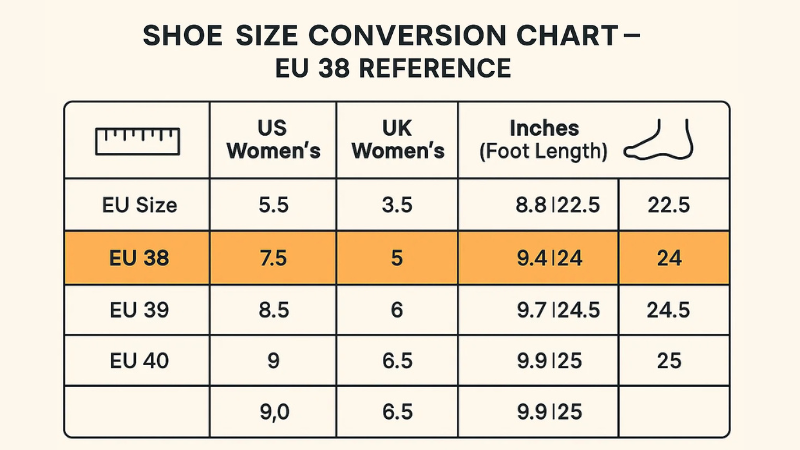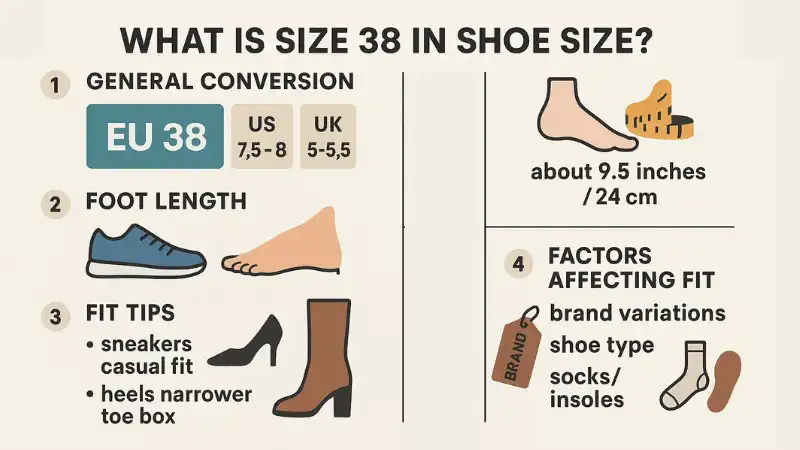Have you ever wondered what size is 38 in women’s shoes? If you shop internationally or buy shoes online, you’ve probably noticed that European sizes like 38 are very common. The challenge is that sizing doesn’t always translate directly across US, UK, and EU systems, which often leads to confusion and misfitting shoes.
The good news? Once you understand how shoe size 38 converts, you can shop confidently, whether it’s for sneakers, boots, or even specific brands like Dansko. In this guide, we’ll break down size 38 conversions, highlight differences between shoe types, and share tips to ensure the perfect fit.
What Size is 38 in Women’s Shoes? Understanding the Size Differences
1. What Is Size 38 in Shoe Size?
If you’ve ever asked yourself, “what is size 38 in shoe size?”, you’re not alone. EU size 38 is one of the most common medium sizes in women’s footwear, but converting it to US or UK sizes can be confusing if you’re used to different sizing systems.
General Conversion
EU 38 ≈ US Women’s 7.5–8
EU 38 ≈ UK Women’s 5–5.5
European sizes are based on foot length in centimeters and, unlike US or UK sizing, they don’t skip half sizes. This makes conversions slightly less straightforward for those shopping across international brands.
Foot Length and Fit
A typical size 38 shoe is designed for a foot that measures about 9.5 inches (24 cm). However, this can vary depending on the type of shoe and the brand:
- Sneakers or casual shoes may have a more relaxed fit and flexible materials, sometimes allowing for half-size adjustments.
- Dress shoes or heels often have a narrower toe box, which can make them feel tighter even if you match the EU 38 conversion exactly.
- Boots may feel snug around the calf or ankle, so it’s essential to account for both foot and leg measurements.
Factors That Affect Sizing
- Brand Variations:
Each brand may have slight differences in how it interprets EU sizing. Checking the brand-specific chart is always recommended.
- Shoe Type:
Athletic shoes, heels, flats, or boots all fit differently due to their design and structure.
- Socks or Inserts:
Thick socks, insoles, or foot orthotics can affect the fit. You may need to size up depending on your intended use.
Practical Tips for Shopping
- Always check sizing charts before buying online. Even a half-size difference can impact comfort.
- Measure your foot length from heel to toe to compare with EU, US, or UK sizes.
- Read reviews and brand notes to understand if a particular shoe runs small, large, or true to size.
By understanding what is size 38 in shoe size and considering factors like foot length, shoe type, and brand, you can shop confidently. You’ll avoid discomfort, unnecessary returns, and the frustration of ill-fitting shoes.
For more guidance on fit, comfort, and choosing the right shoes, see Best Nursing Shoes for Flat Feet. These will be the most comfortable ones if you happen to have flat feet.
2. What Size Is a 38 in Women’s Boots?
Boots can be a little trickier to size than sneakers or flats. If you’re wondering “what size is a 38 in women’s boots?”, understanding the nuances of fit can save you discomfort and unnecessary returns. Generally, EU size 38 corresponds to US Women’s 7.5–8, but boots often fit differently due to style, materials, and construction.

Key Factors to Consider
- Style Variations
- Ankle boots usually fit closer to standard shoe sizes, but some designs may run narrow.
- Knee-high or tall boots can feel snug around the calves even if the foot size is accurate.
- Work or hiking boots are sometimes built with more structure and padding, affecting how the size feels.
- Insulation and Lining
Boots designed for colder weather often come with thicker linings or insulation. This extra material can make a size 38 feel tighter than usual, so consider sizing up slightly if you plan to wear heavy socks.
- Sock Thickness
The type of socks you wear significantly affects boot fit. Winter or wool socks can add bulk, while thin socks may allow a closer, more precise fit. Always factor in the socks you’ll most commonly wear with the boots.
- Brand-Specific Size Charts
Boot sizing can vary widely between brands, more so than casual shoes. Always check the brand’s official boot sizing chart before purchasing online, and read customer reviews for insights on fit.
- Practical Tips for Shopping
- Try before you buy whenever possible, especially for tall or structured boots.
- Measure your foot length and calf circumference to compare with the brand’s chart.
- Be prepared to adjust sizing slightly for thicker socks, insulation, or specific boot designs.
3. What Size Is 38 in Women’s Dansko Shoes?
Dansko is a well-known brand, especially popular for its clogs and professional footwear. However, when it comes to sizing, Dansko shoes can feel a bit different compared to other brands. If you’re wondering “what size is 38 in women’s Dansko shoes?”, here’s what you need to know:

General Conversion
EU 38 ≈ US Women’s 7.5–8
This is consistent across most Dansko styles, including clogs, shoes, and boots.
Fit Considerations for Dansko Shoes
- Roomy Toe Box:
Dansko clogs and shoes are intentionally designed with extra space in the toe area. This gives your toes more wiggle room, which is ideal for long hours of wear, but may feel larger than other shoes of the same size.
- Sizing Between Sizes:
If you find yourself between sizes, some wearers suggest sizing down for a snugger fit, especially in clogs. Conversely, if you prefer a more relaxed fit, stick to your usual EU 38.
- Break-In Period:
Dansko footwear often molds to your feet over time. Expect a short break-in period before they feel perfectly comfortable.
- Socks and Inserts:
Wearing thick socks, especially in colder months, can affect the fit. Custom insoles or thinner socks may help achieve a more precise fit.
Practical Tips
- Try on shoes later in the day when your feet are slightly swollen to ensure comfort.
- Check customer reviews for insights on how a particular style fits, since some clogs may feel roomier than shoes or boots.
Always refer to the brand’s official size guide to confirm the best size for your foot length.
4. Shoe Size Conversion Chart (EU 38 Reference)
Here’s a simple chart to help you quickly compare EU size 38 with other sizing systems and foot measurements:

As you can see, EU 38 falls right in the middle range, making it a very common size in women’s footwear.
Tips for Buying Shoes in Size 38 Online
Shopping for shoes online can be challenging, especially when it comes to EU size 38, because you can’t try them on before purchase. With a few smart strategies, you can make sure your shoes fit comfortably and avoid returns or disappointments.
1. Always Check Brand-Specific Conversion Charts
Not every brand interprets EU sizing the same way. For example, a size 38 in sneakers might feel different from a size 38 in heels or boots. Always consult the brand’s official size chart to ensure you’re choosing the right fit for that specific style.
2. Consider the Shoe Type
- Boots:
These often require sizing up, particularly if you plan to wear thick socks or insulated liners.
- Clogs or Slip-Ons:
These may run slightly larger than your standard size due to their roomy design.
- Sneakers:
Generally, sneakers fit true to size, but check reviews for exceptions, especially in performance or running shoes.
3. Read Customer Reviews
Customer feedback is invaluable. Look for comments about whether the shoes run small, large, or true to size. Real-life experiences often give a more accurate picture than charts alone.
4. Measure Your Foot Length
Take an accurate measurement of your foot—from heel to the tip of your longest toe—and compare it to the brand’s sizing chart. This step can prevent guesswork and improve the likelihood of a perfect fit.
5. Check Return and Exchange Policies
Even with careful measuring and chart comparisons, sizing can vary. Make sure the store offers free returns or exchanges so you can easily adjust if the shoes don’t fit as expected.
Pro Tip:
When possible, read multiple reviews across different sizes and styles to see if the fit is consistent. Some brands are known for slightly narrower or wider fits in certain collections.
By following these tips, shopping for size 38 shoes online can be straightforward and stress-free, helping you find footwear that’s both comfortable and stylish.
For the best fit, comfort and style, see Best Nursing Shoes.
Conclusion
To recap, EU size 38 generally equals US women’s 7.5–8, but fit can vary depending on shoe type, brand, and width. Boots, clogs, and heels may feel slightly different, so checking brand-specific size charts and reading customer reviews is always a smart move.
Whether you’re buying sneakers, boots, or Dansko shoes, knowing your EU 38 conversion can help you shop online confidently and avoid returns. Focus on comfort and proper fit rather than just the number on the box.
FAQs About Size 38 in Women’s Shoes
Is EU size 38 the same as US size 8?
In most cases, yes—EU 38 = US women’s size 7.5–8. However, sizing can vary slightly depending on the brand and shoe type.
Does size 38 fit wide feet?
EU 38 shoes are usually designed with a standard or narrow width. If you have wide feet, you may need to look for wide fit options or consider sizing up.
What size is 38 in women’s heels?
For heels, EU 38 is about US 7.5–8. Since heels can run small due to pointed toes, some women prefer to size up for comfort.
Are Dansko shoes true to size for EU 38?
Yes—EU 38 in Dansko shoes typically equals US 7.5–8. However, Dansko clogs are known to feel slightly roomy, which many people find comfortable for long wear.
Should I size up or down in boots if I wear EU 38?
For boots, many people recommend sizing up half a size if you plan to wear thicker socks. Always check the brand’s sizing guide before purchasing.


Leave a Reply